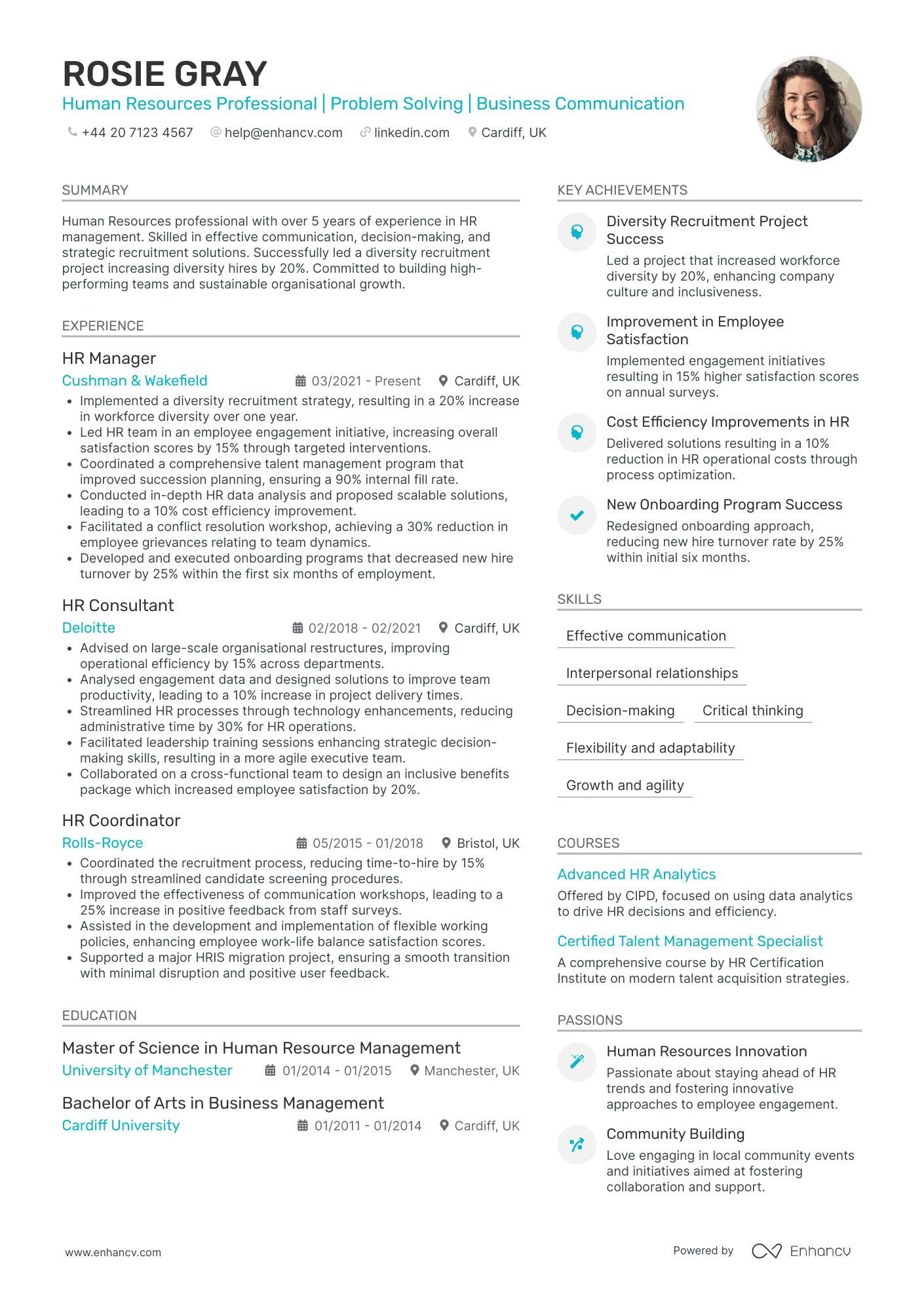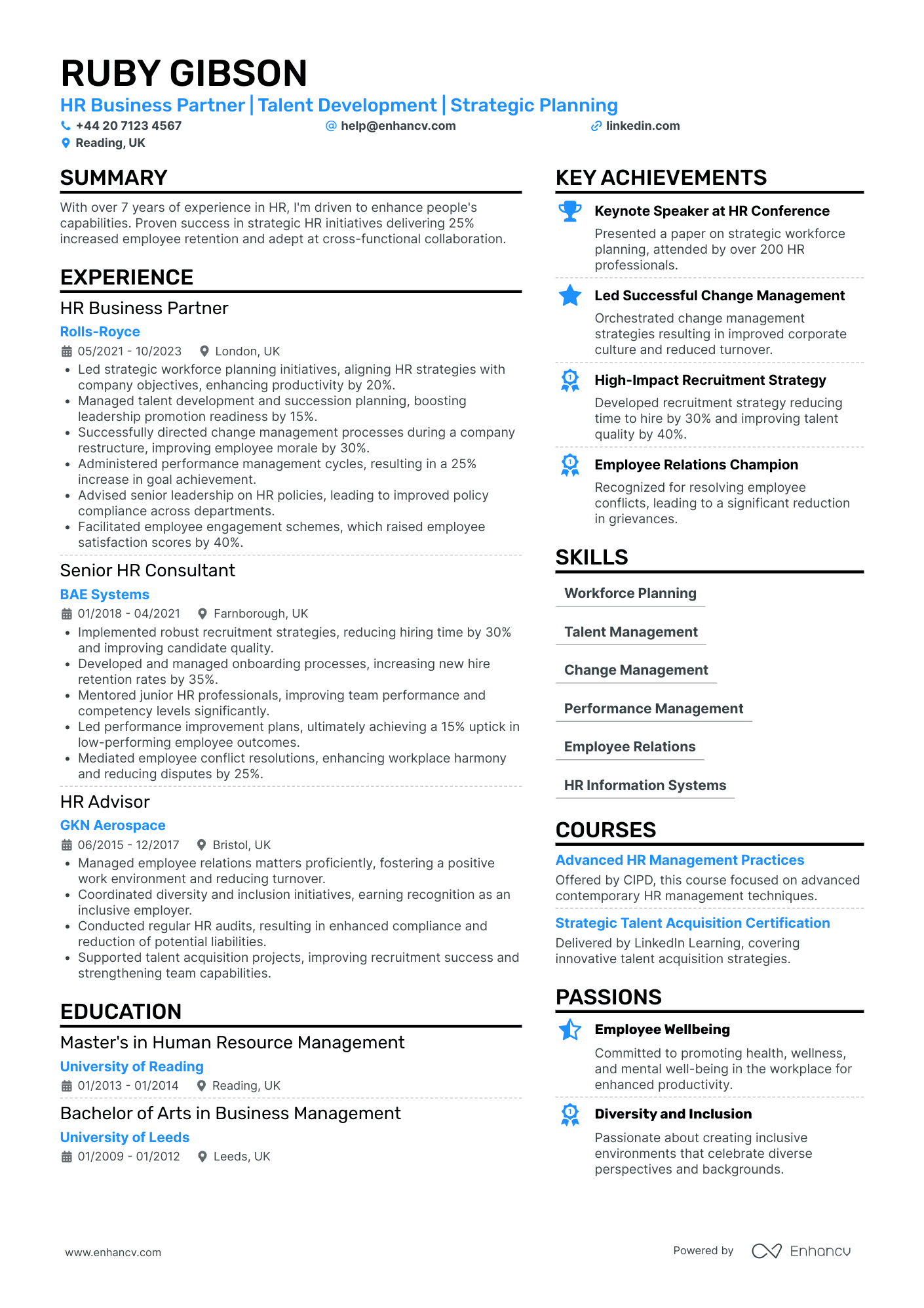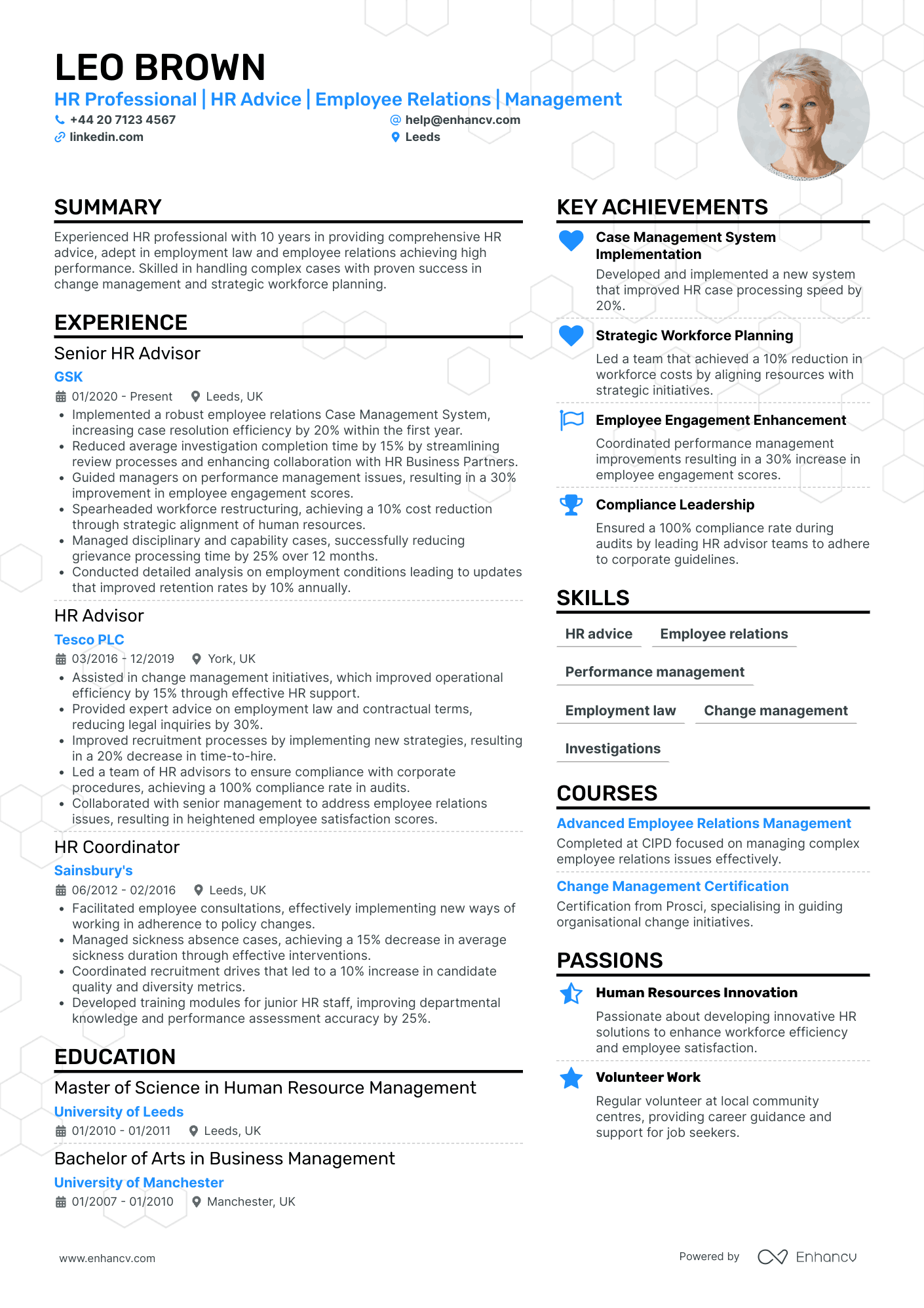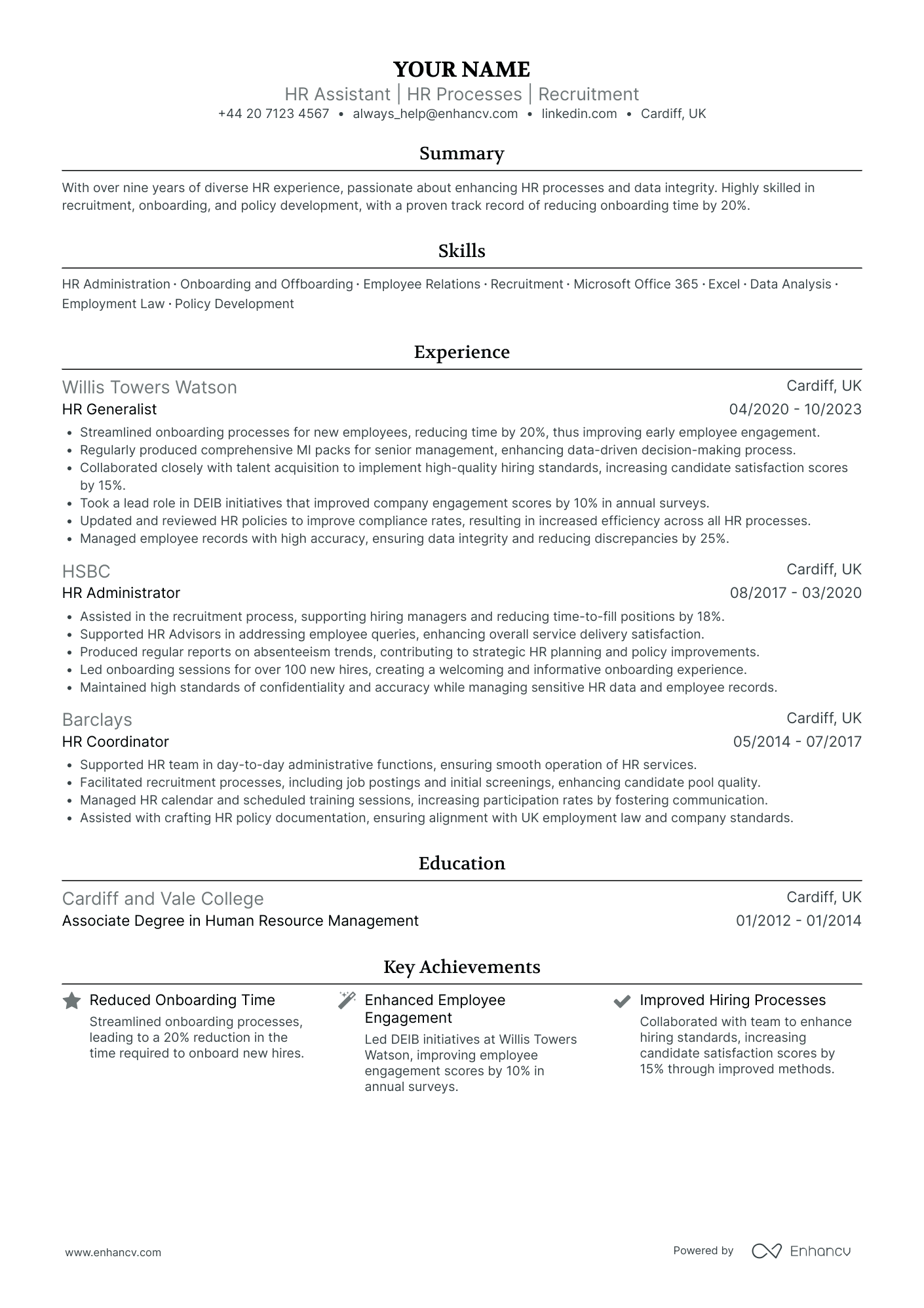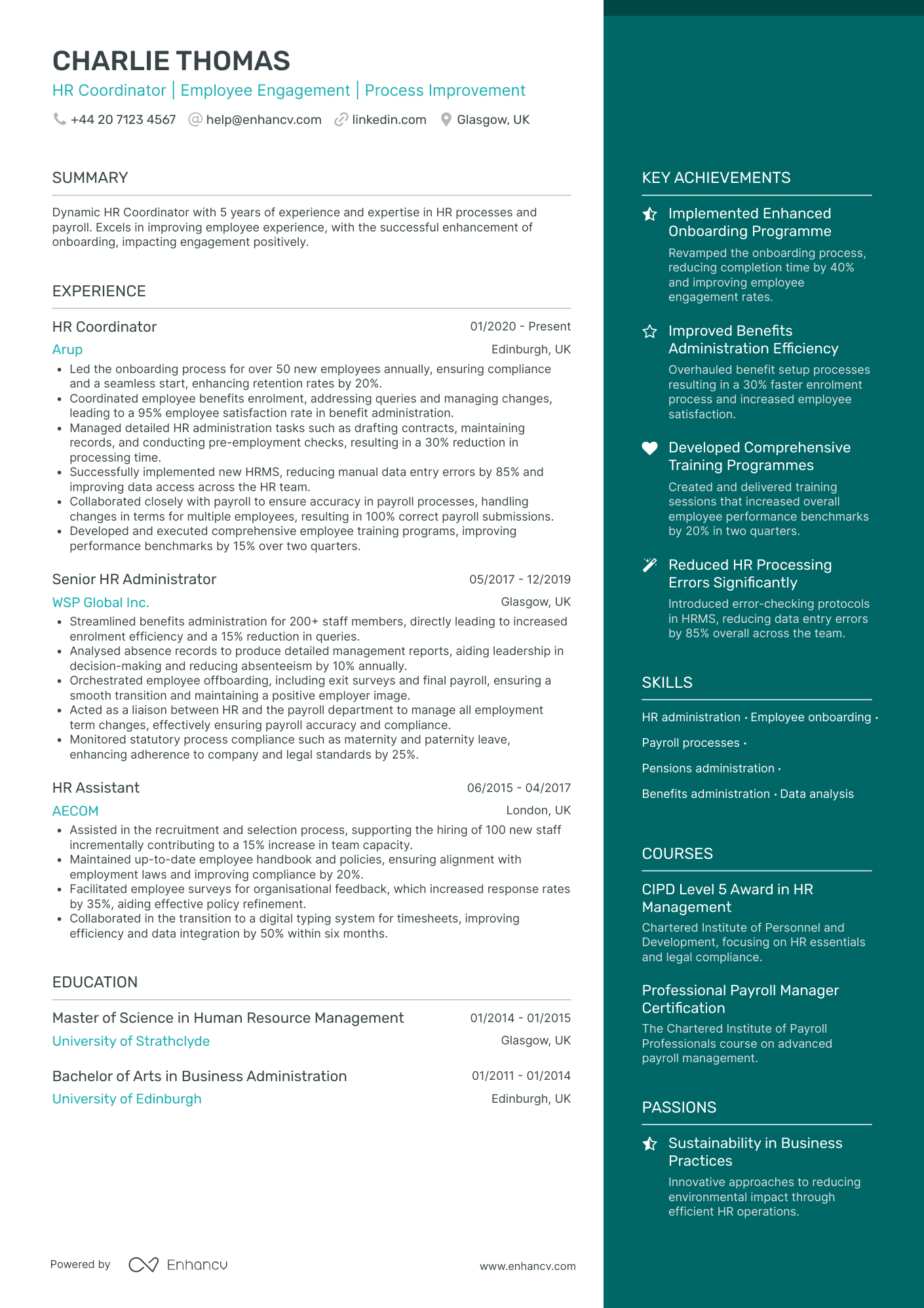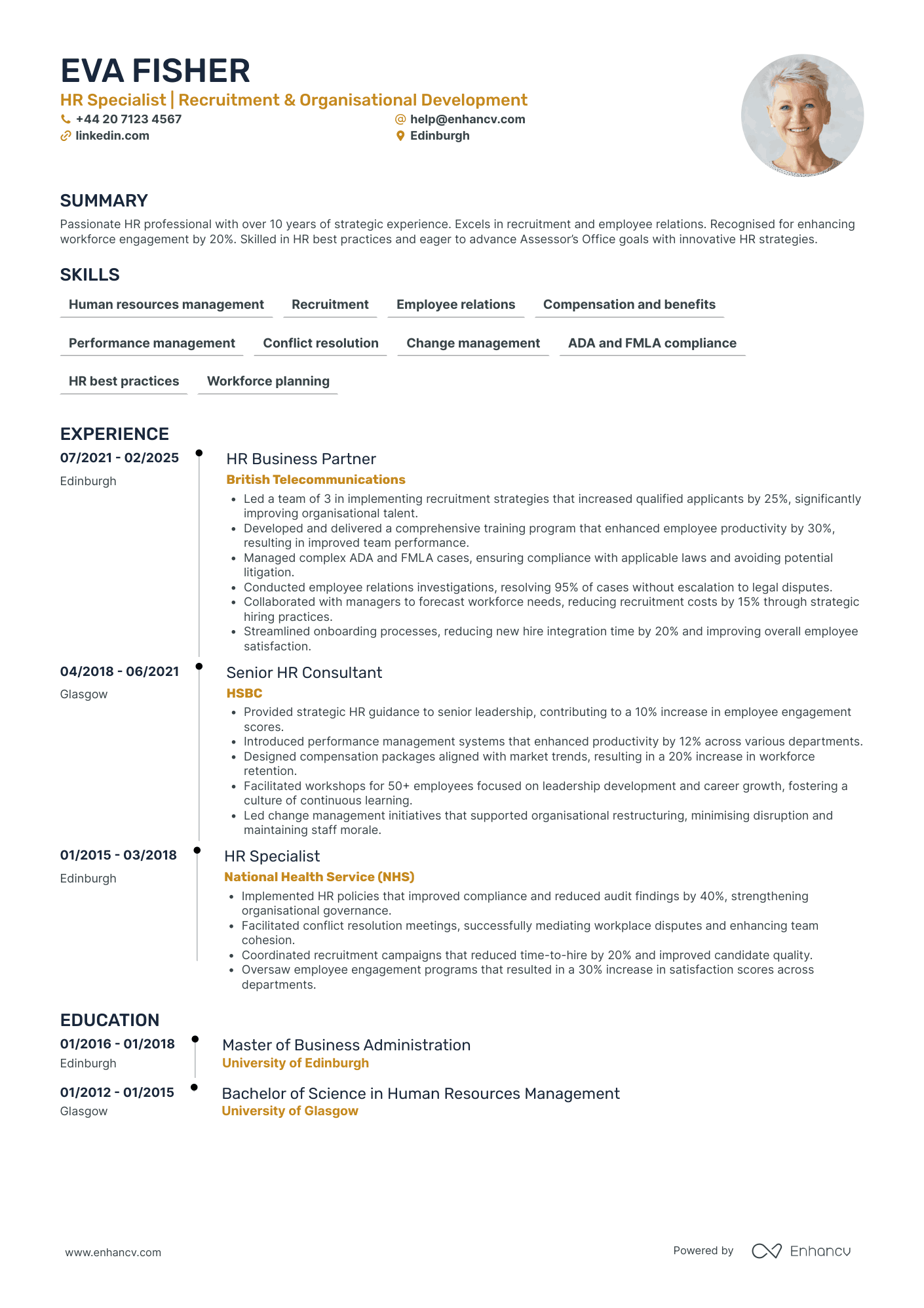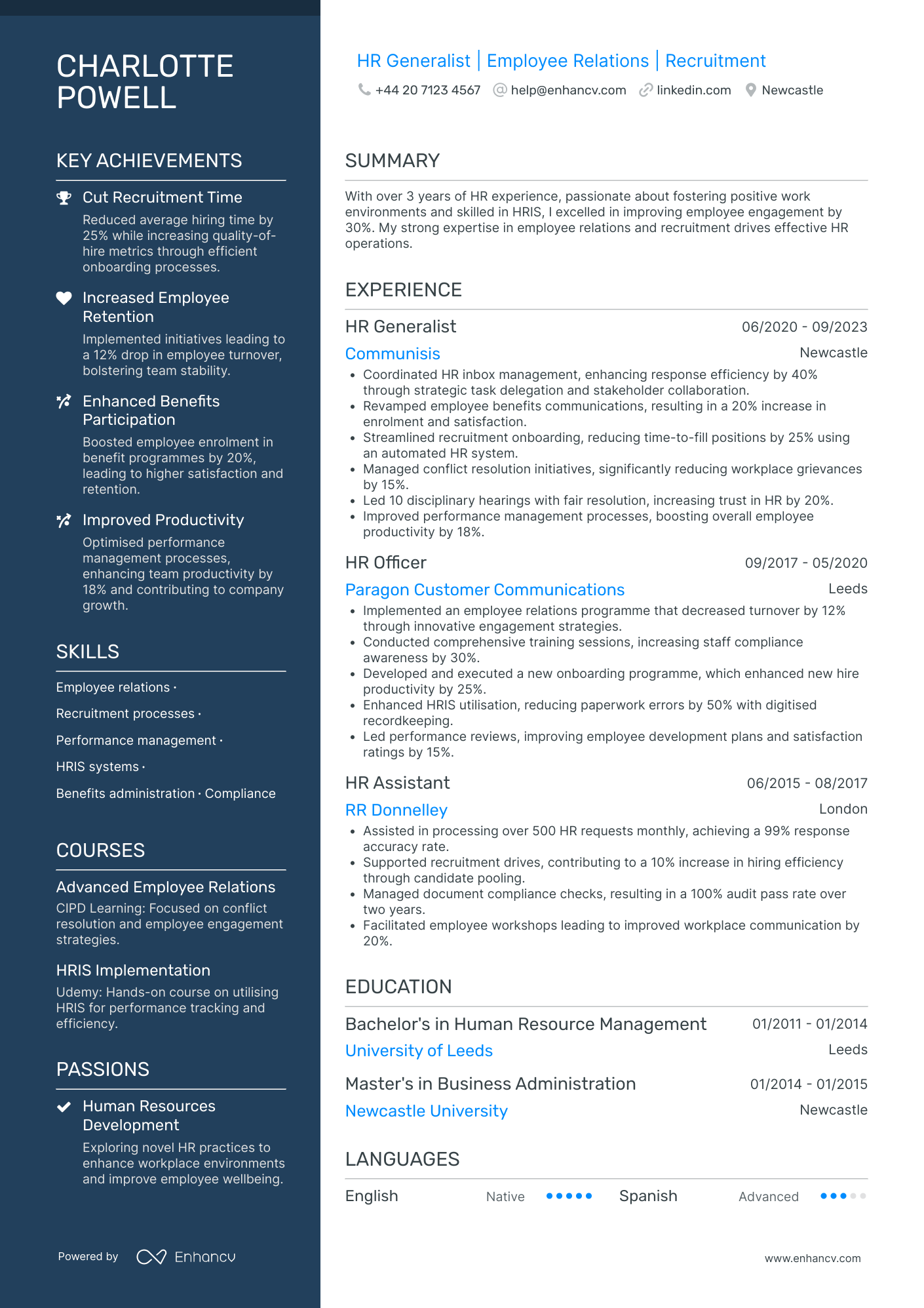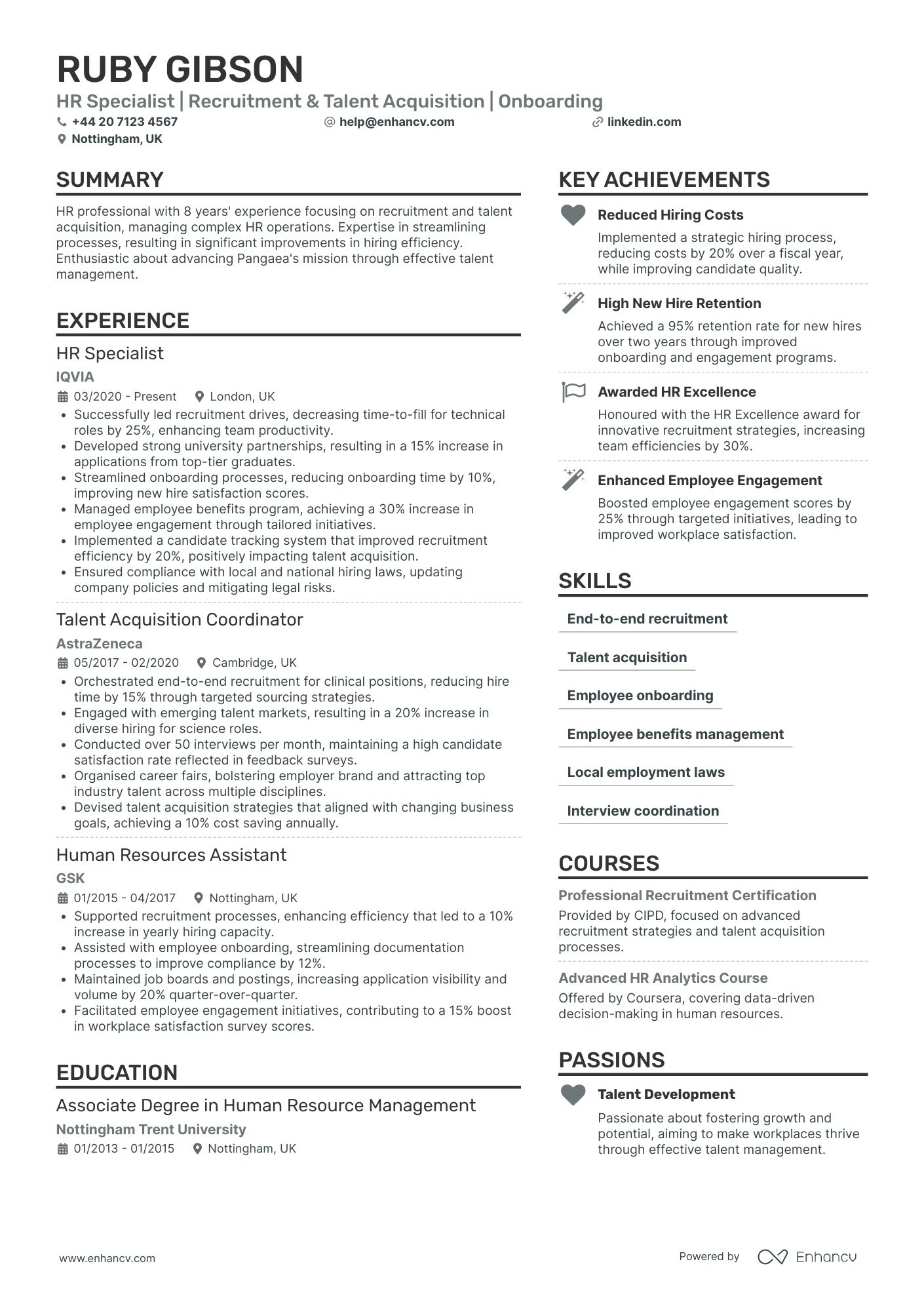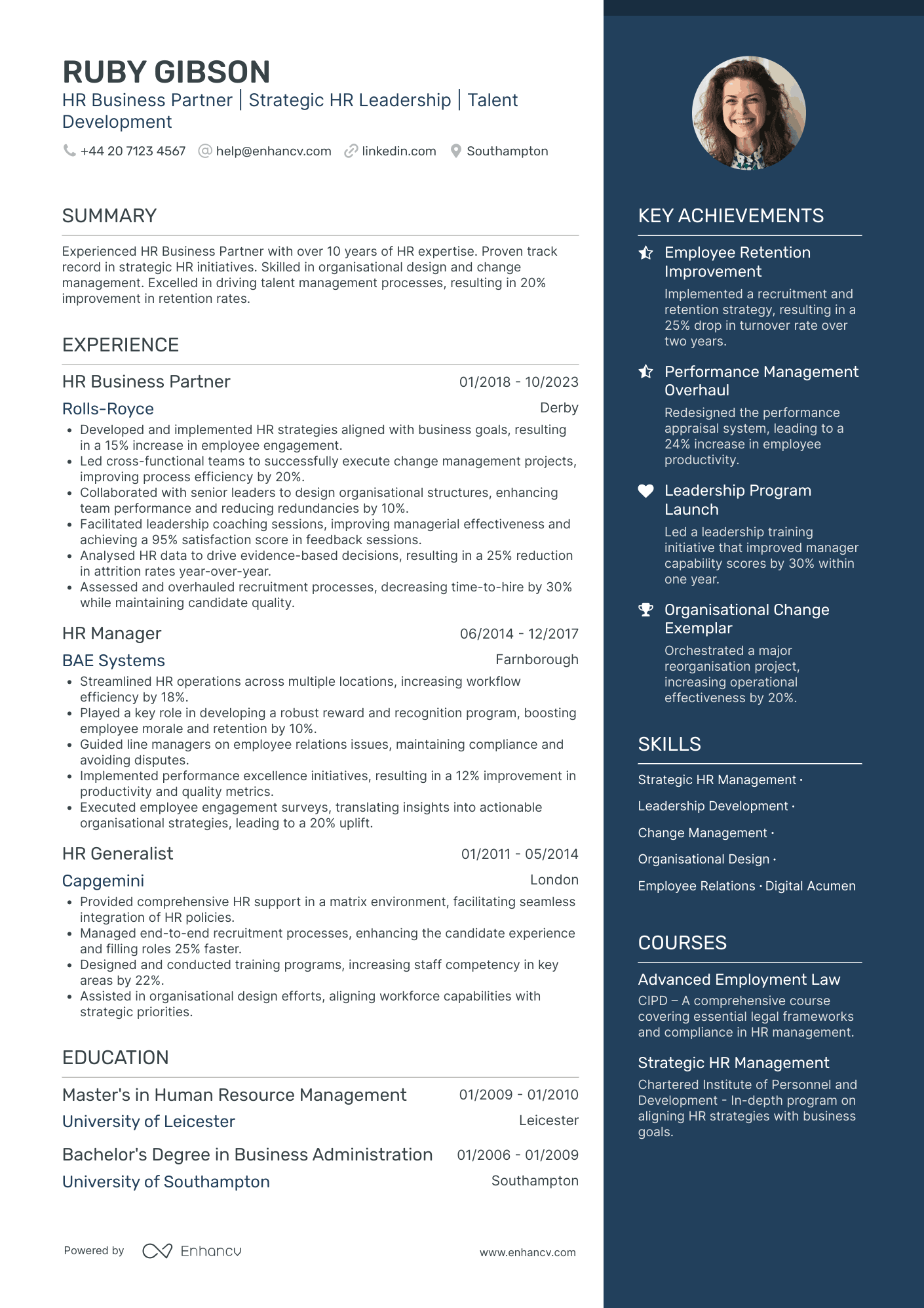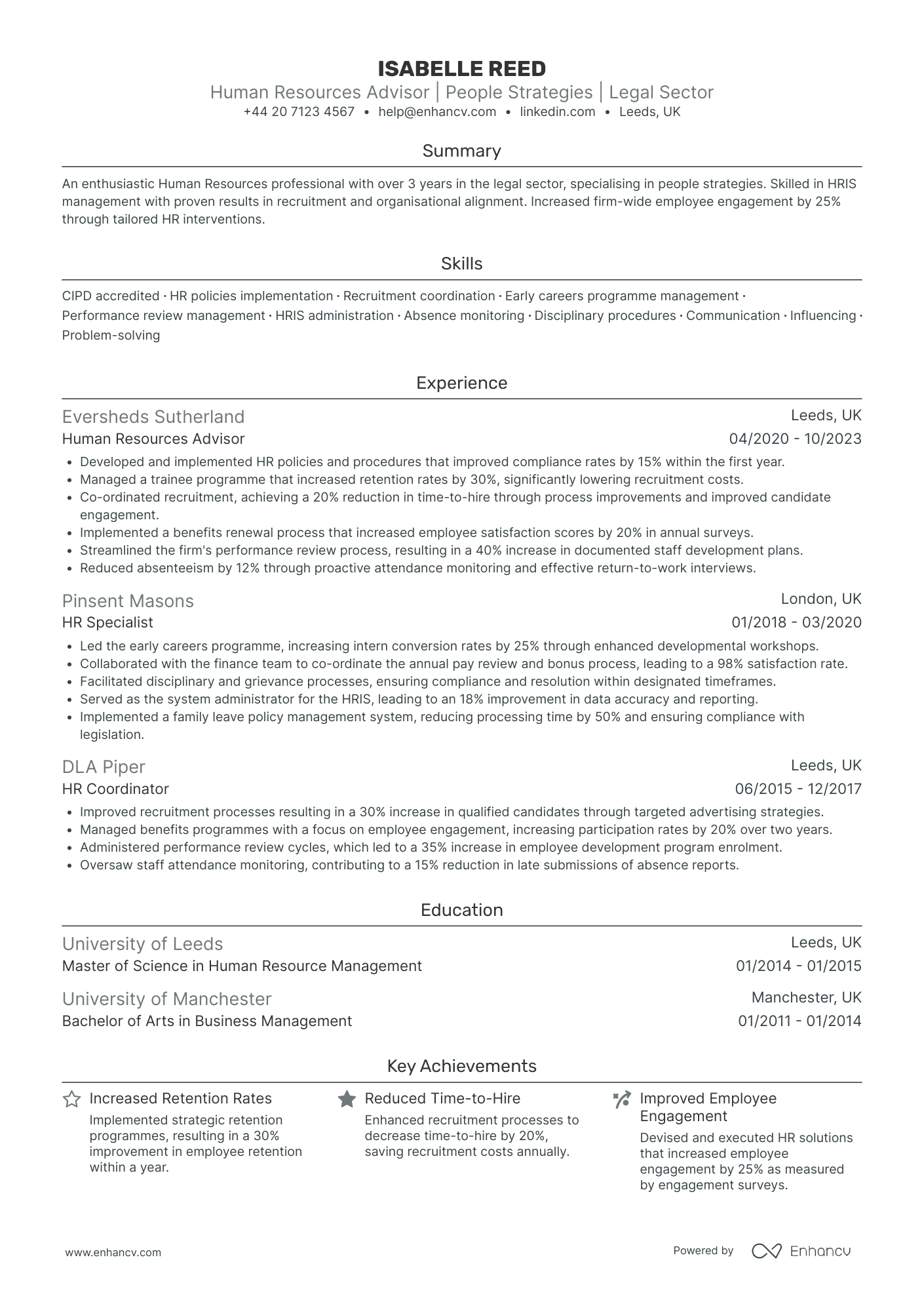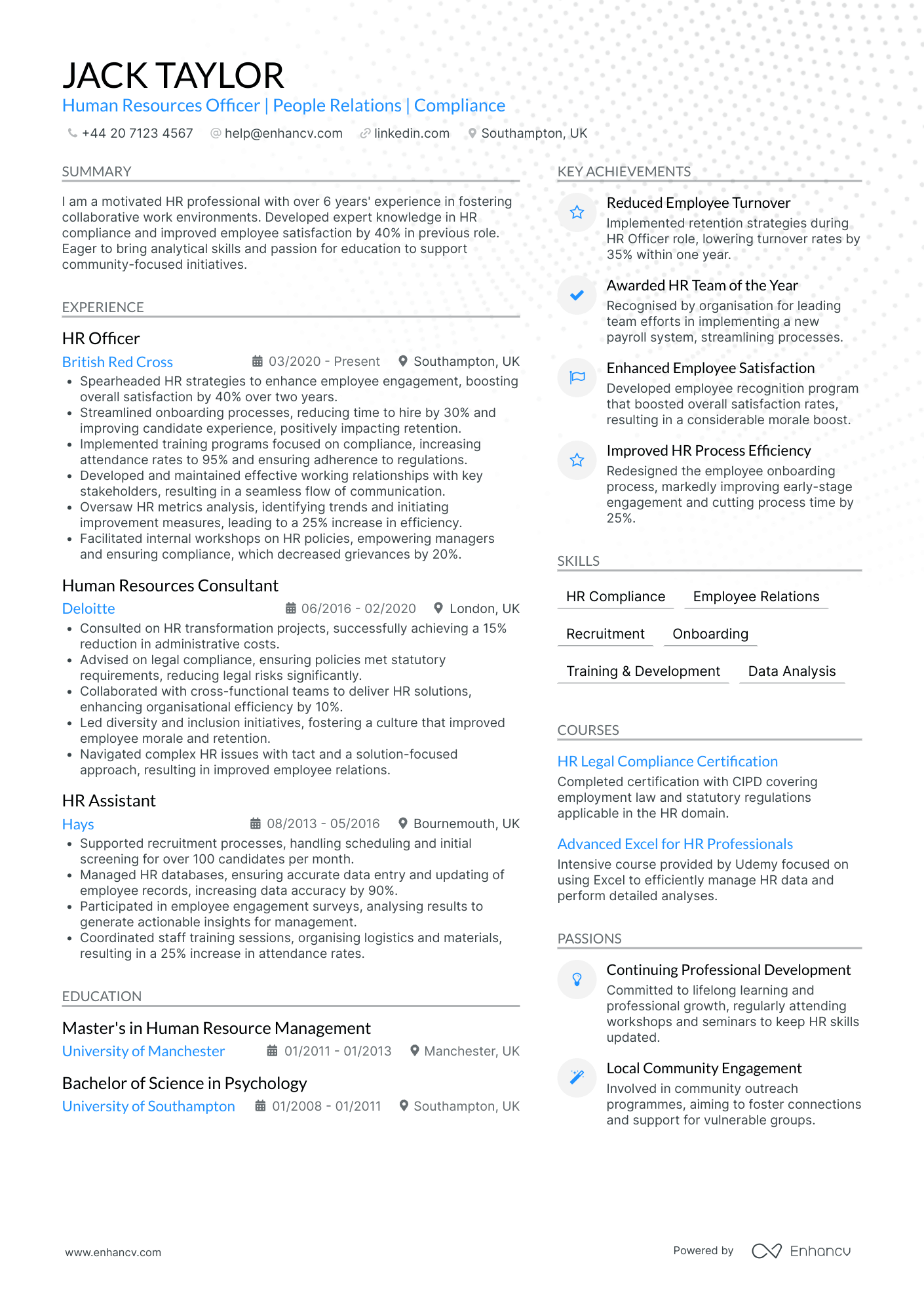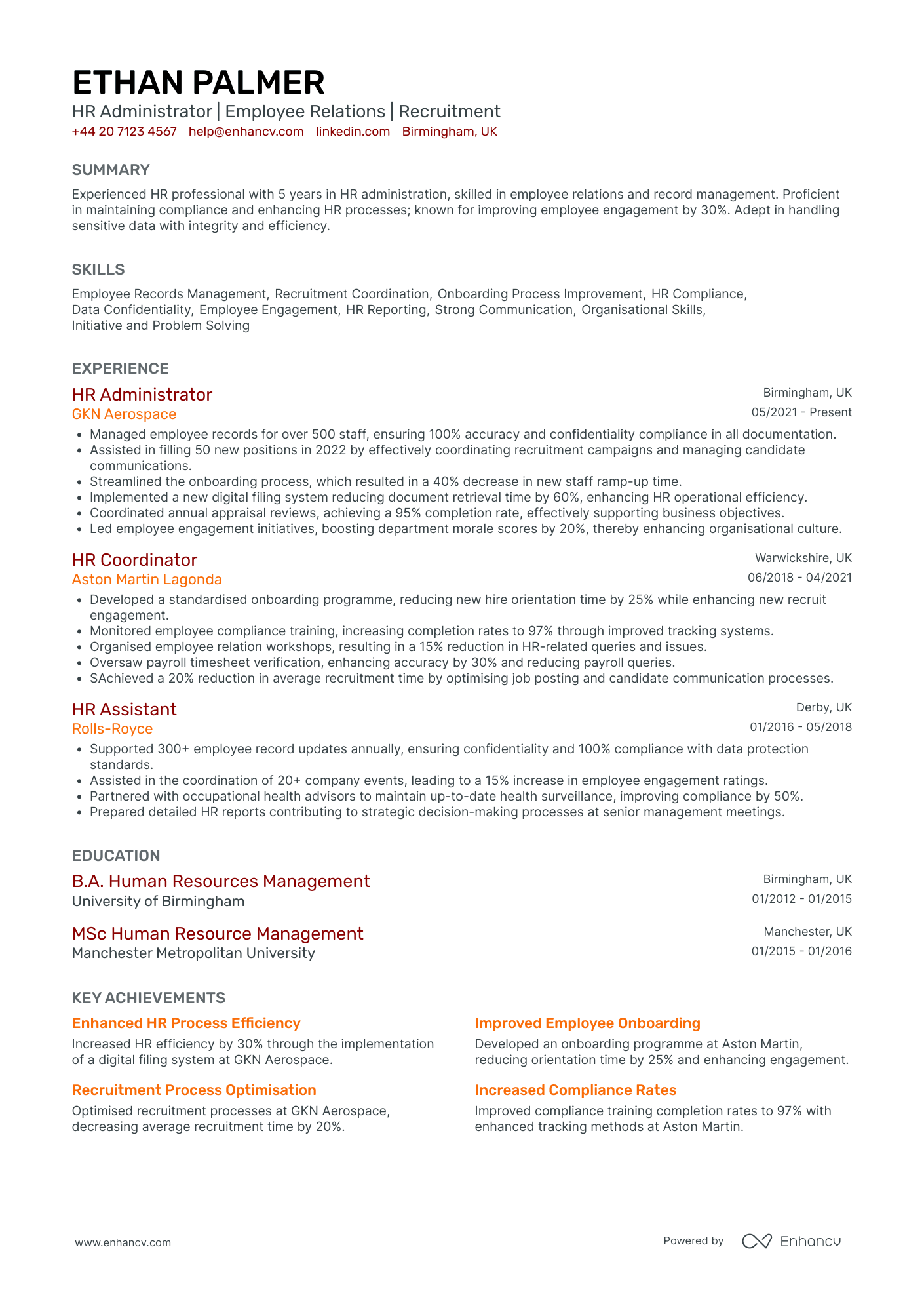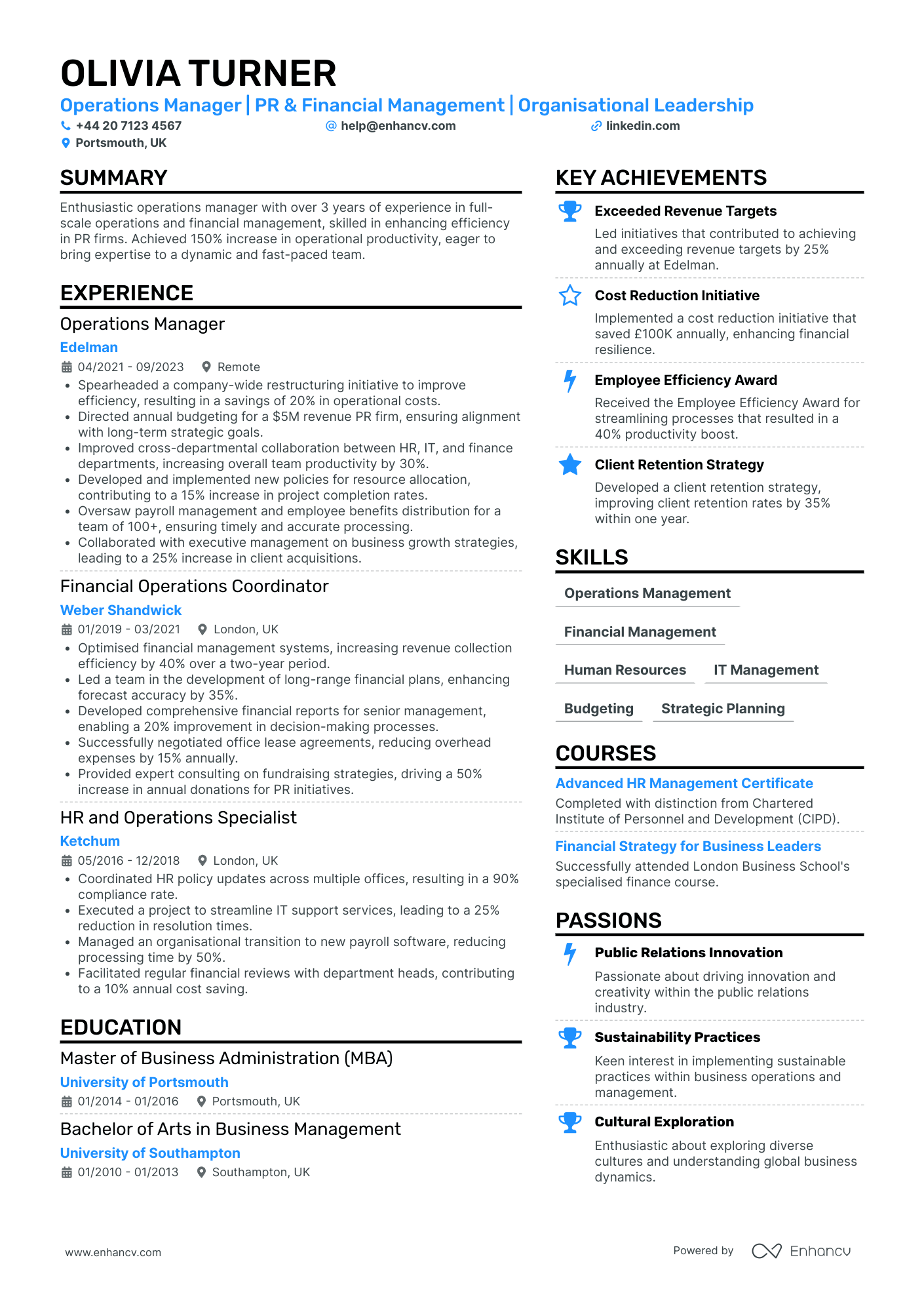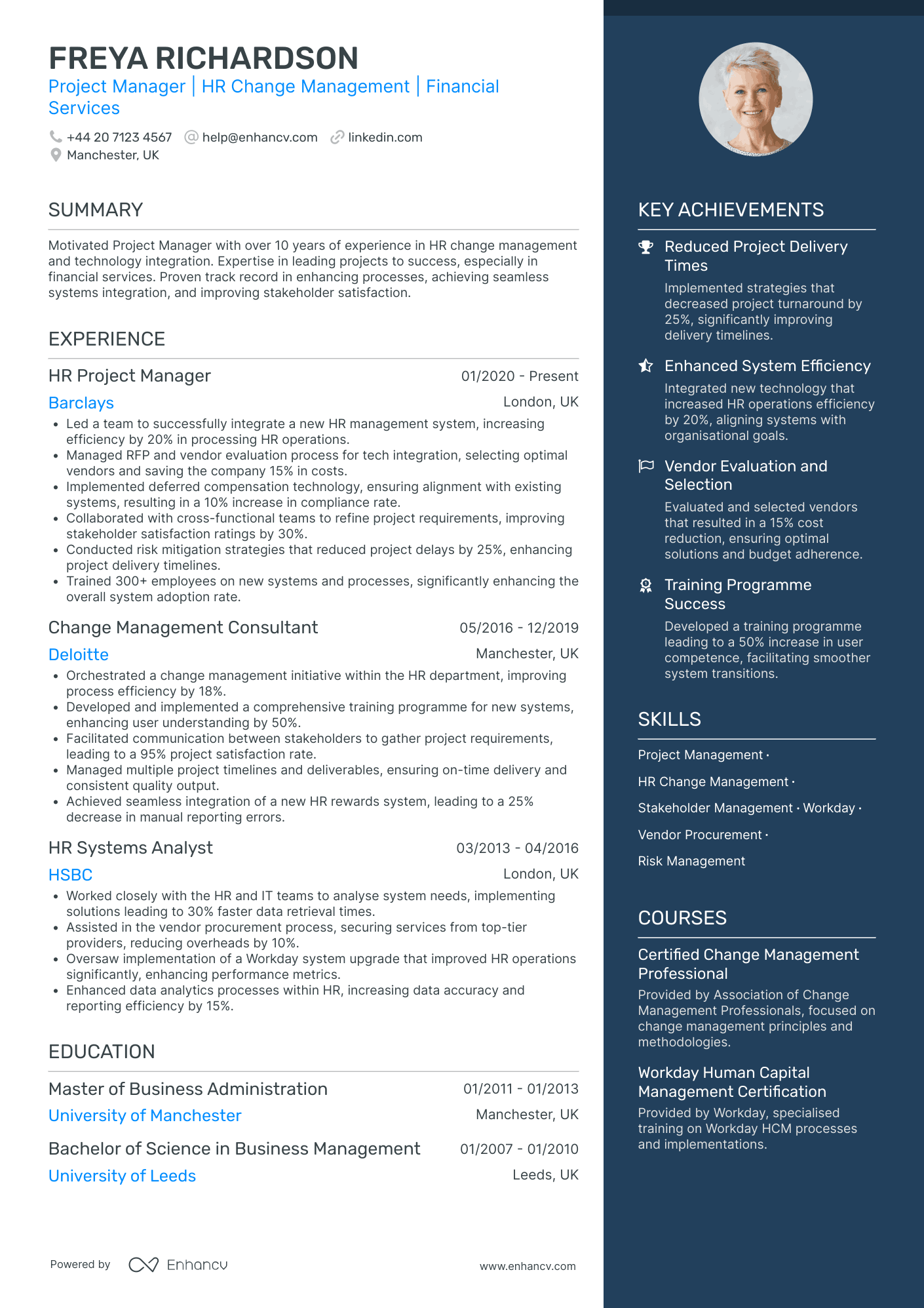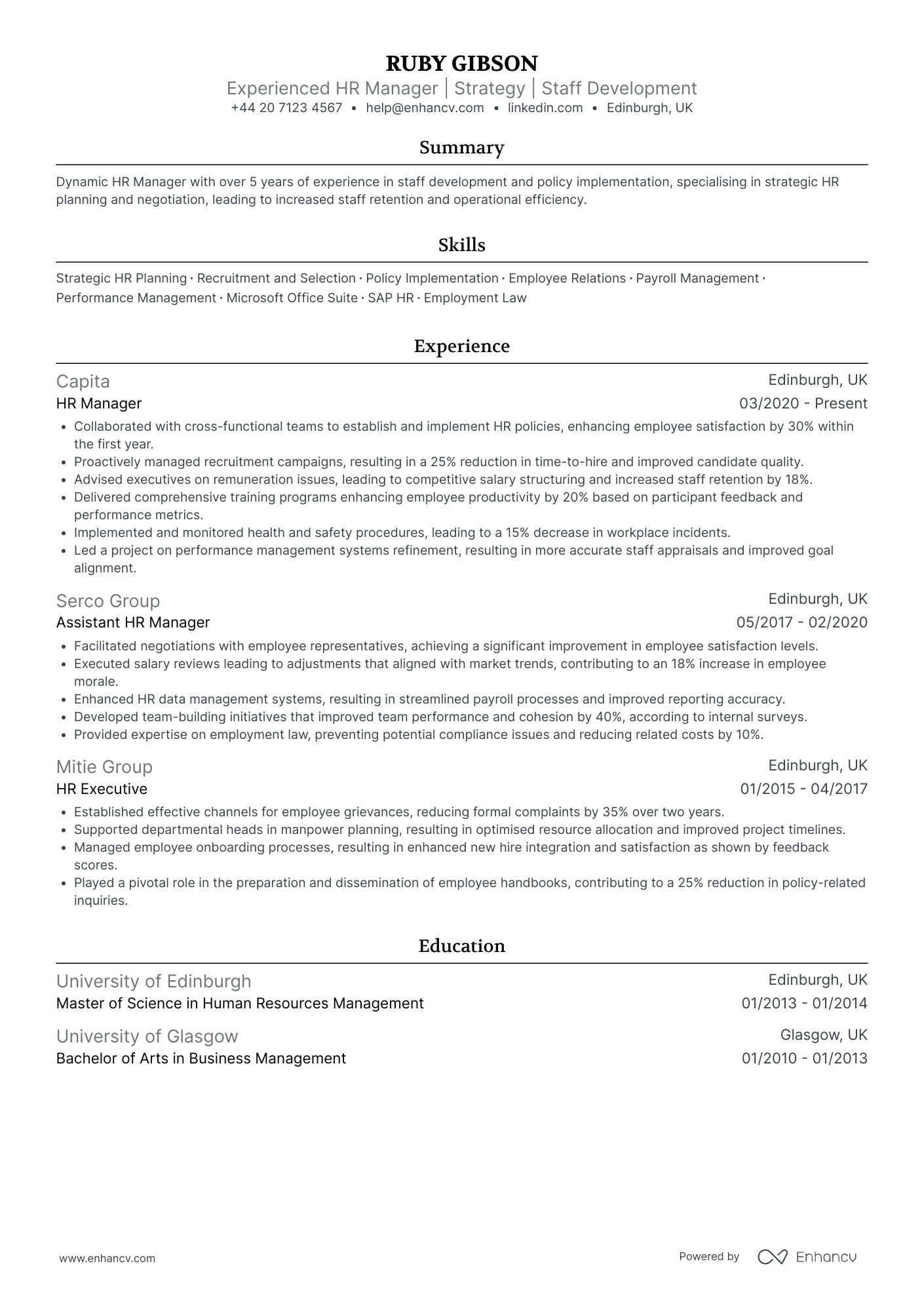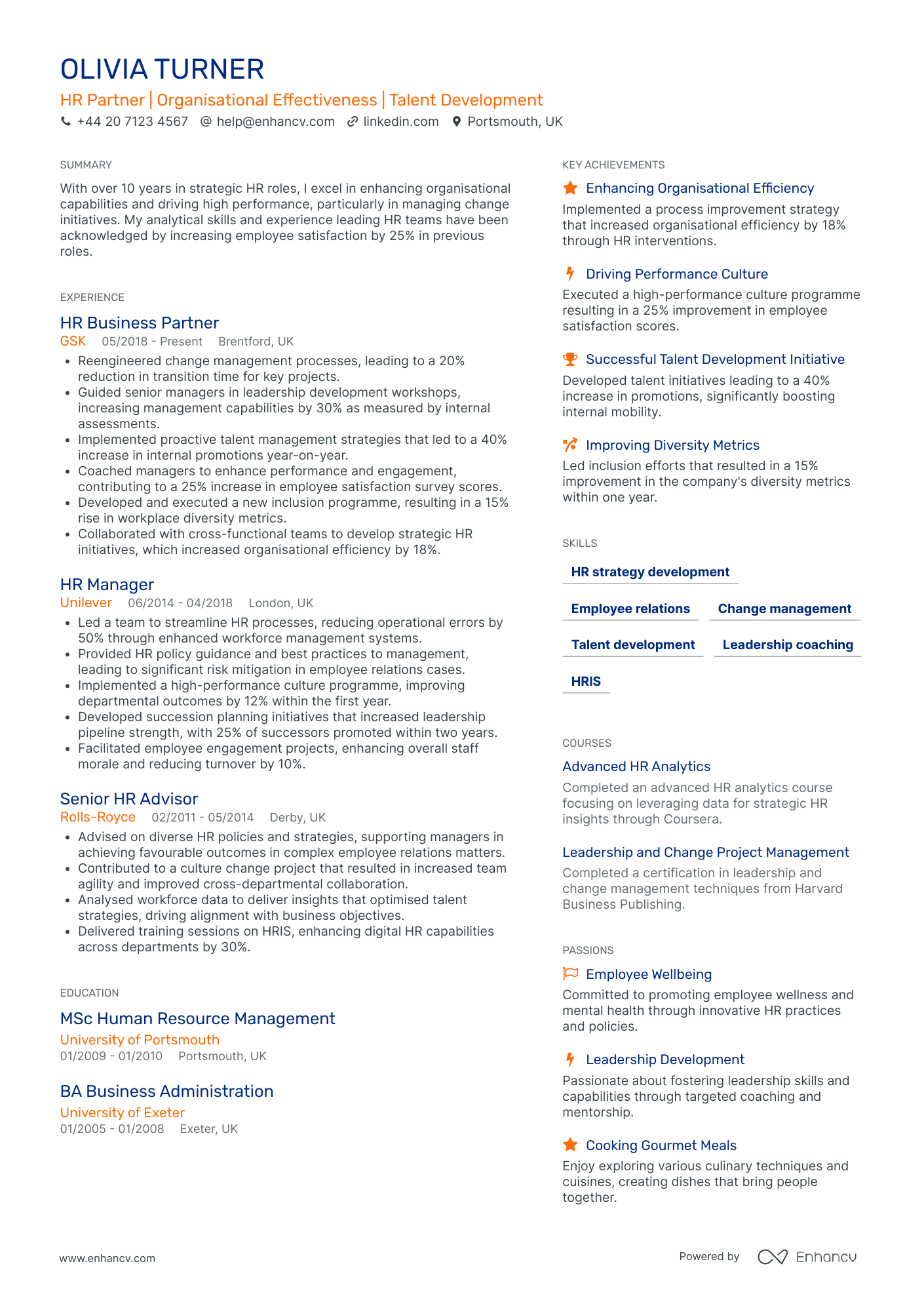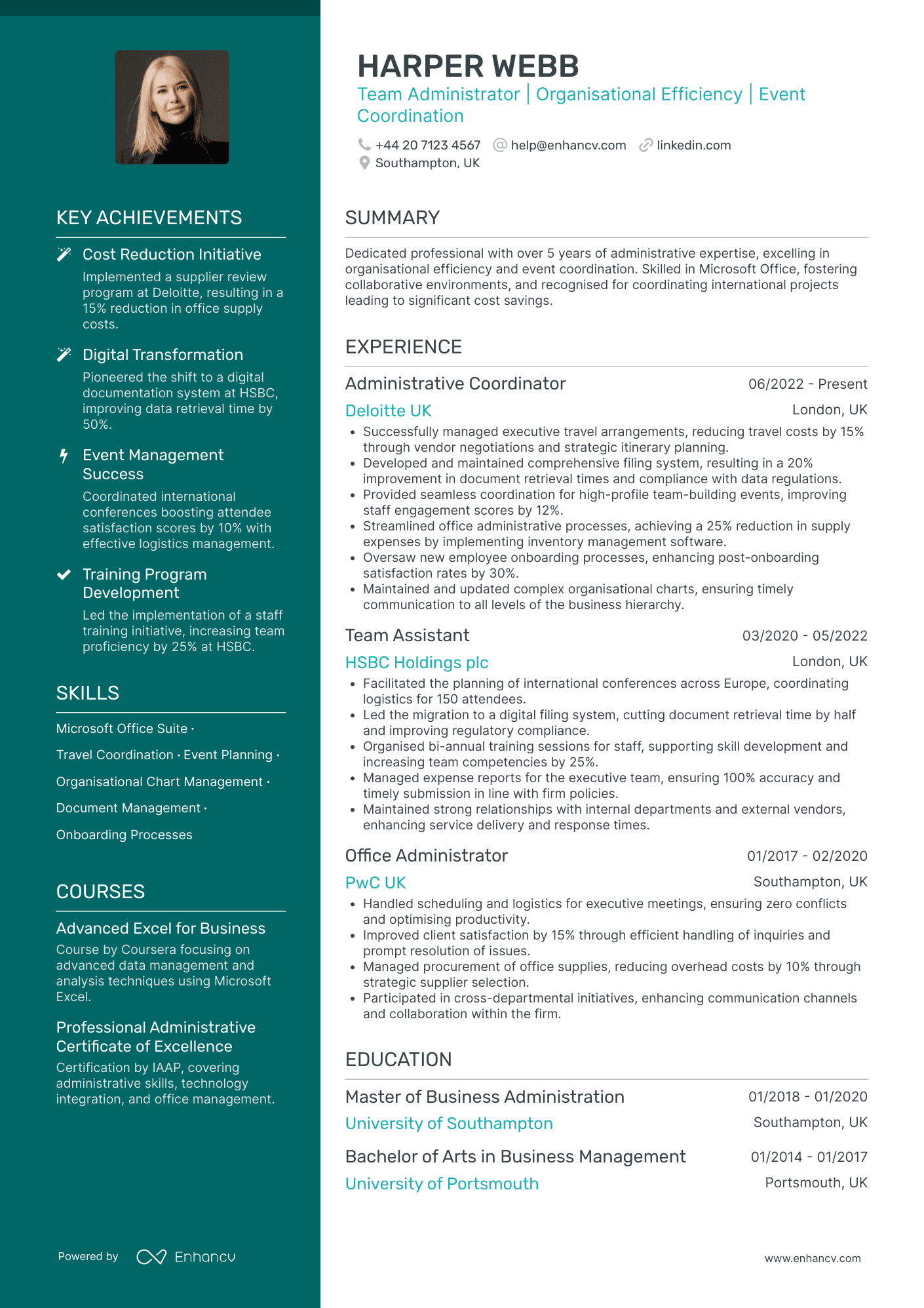One specific CV challenge faced by human resources is the difficulty in accurately assessing a candidate's potential from a static document. By referring to our comprehensive guide, you'll learn innovative strategies for interpreting CV details, allowing you to more effectively predict how an applicant's experiences and skills will translate to their performance on the job.
- Create an attention-grabbing header that integrates keywords and includes all vital information;
- Add strong action verbs and skills in your experience section, and get inspired by real-world professionals;
- List your education and relevant certification to fill in the gaps in your career history;
- Integrate both hard and soft skills all through your CV.
Discover more industry-specific guides to help you apply for any role in the links below:
Resume examples for human resources
By Experience
Entry-Level Human Resources Professional
- Structured presentation and clarity - Rosie's CV excels in clarity and structure, presenting information in a well-organized manner. It uses clear headings and bullet points that make it easy to navigate, allowing for quick identification of her key skills, achievements, and experience. This ensures that her qualifications are immediately apparent to potential employers.
- Demonstrates career growth and progression - The career trajectory in Rosie's CV shows a clear path of advancing responsibilities and promotions. From her beginnings as an HR Coordinator at Rolls-Royce to her current HR Manager role at Cushman & Wakefield, it is evident that she has progressively built upon her expertise, gaining valuable experience across distinct roles in the HR industry.
- Highlight on adaptability and cross-functional collaborations - Rosie’s CV reflects her adaptability and experience working across different functions. Her roles involved collaborating on organizational restructures and cross-functional initiatives, such as developing inclusive benefits packages, showcasing her ability to work effectively across departments to drive company-wide improvements.
Senior Human Resources Professional
- Structured and Concise Presentation - The CV is organized with clearly defined sections like experience, education, skills, and achievements, which makes it easy to follow. Each section is presented concisely, with bullet points highlighting key accomplishments, ensuring the reader can quickly grasp the candidate's significant contributions and expertise.
- Progressive Career Development - Ruby Gibson's career trajectory showcases a clear progression from HR Advisor to HR Business Partner, highlighting her ability to take on greater responsibilities and influence within the HR field. Her advancement through prominent companies like GKN Aerospace, BAE Systems, and Rolls-Royce underscores her capability and reputation in the industry.
- Strong Emphasis on Achievements with Business Impact - The CV provides detailed evidence of impactful achievements, such as boosting employee satisfaction scores by 40% and increasing employee retention by 25%. These quantifiable results highlight Ruby's ability to influence organizational efficiency and employee engagement positively.
By Role
Human Resources Manager
- Structured for Quick Insights - This CV is meticulously organized, allowing readers to swiftly locate and comprehend key information. It adheres to a logical layout where each section seamlessly flows into the next, enhancing clarity and ensuring that potential employers can assess the candidate's qualifications and experiences effortlessly.
- Impressive Career Advancement - The CV illustrates a notable progression in the candidate's career, with evidence of consistent promotions and increased responsibilities across several roles in the tech industry. It showcases a clear upward trajectory, indicating a dedication to professional development and leadership growth.
- Technical Proficiency in Emerging Technologies - One notable aspect of the CV is its emphasis on proficiency with cutting-edge technologies relevant to today’s digital world. It highlights the candidate's expertise in using advanced data analytics tools and machine learning methodologies, which are critical in driving innovation and strategic decisions within tech-driven organizations.
Human Resources Assistant
- Structured and Concise Presentation - The CV is well-organized, providing clear headings for each section, such as experience, education, skills, and achievements. Each position under experience is briefly narrating a story of success through bullet points, ensuring that a hiring manager can quickly grasp Sophia's qualifications and strengths.
- Professional Growth and Role Expansion - Sophia's career trajectory exhibits steady progression, from starting as an HR Coordinator and advancing to an HR Generalist. This growth reflects not only an increasing level of responsibility and skill development but also a dedication to the field of HR within reputable companies like Willis Towers Watson and HSBC.
- Impactful Achievements with Business Relevance - The CV stands out by translating Sophia's contributions into tangible business results. Achievements like reducing onboarding time by 20% and improving engagement scores by 10% demonstrate her ability to implement effective HR strategies that positively impact organizational efficiency and employee satisfaction.
Human Resources Coordinator
- Emphasis on Process Improvement and Results - Charlie's CV distinctly highlights their capability to enhance HR processes, with numerous references to improvements such as a 30% reduction in processing time and an 85% reduction in data entry errors. This sets them apart by underlining their proactive approach to tackling inefficiencies and delivering measurable benefits to their employers.
- Leadership in Employee Engagement - The CV makes a concerted effort to spotlight Charlie’s leadership in fostering a positive work environment. Their work with onboarding programs, employee benefits, and engagement initiatives demonstrates a significant focus on ensuring high employee satisfaction, which is essential for any organization aiming to maintain morale and reduce turnover.
- Comprehensive Industry-Specific Skills - By listing industry-specific certifications such as the CIPD Level 5 Award in HR Management and the Professional Payroll Manager Certification, along with a robust educational background in HR and business administration, Charlie reinforces their deep knowledge of the HR field. These qualifications showcase their dedication to maintaining professional development and staying abreast of HR trends and legal compliance.
Human Resources Analyst
- Clear and Structured Presentation - The CV is organized in a concise manner with distinct sections for each aspect of the candidate's experience, education, and skills. The sections are clearly labeled, making it easy to follow Eva Fisher's career history and accomplishments. This clarity in structure enhances readability and ensures that key information is highlighted effectively.
- Progressive Career Trajectory - Eva Fisher's career path shows significant growth, moving from an HR Specialist to a Senior HR Consultant, and then to an HR Business Partner. This progression demonstrates her ability to adapt and succeed in increasingly responsible roles, reflecting her skill in managing and leading HR initiatives. The trajectory showcases her commitment to continuous professional development.
- Impactful Achievements with Business Relevance - The CV lists numerous achievements that go beyond mere numbers, emphasizing business impact. Examples include reducing recruitment costs by 15% through strategic hiring practices and enhancing employee productivity by 30% via comprehensive training programs. These accomplishments underline her capacity to drive organizational success and improve operational efficiency.
Human Resources Generalist
- Structured and concise presentation - The CV is both clear and well-organized, breaking information into relevant sections that make it easy for recruiters to quickly identify key details. The use of bullet points and chronological listings enhances readability and allows the hiring manager to grasp the candidate's qualifications and achievements at a glance.
- Progressive career development - Charlotte Powell's career trajectory is notable, showcasing a continuous ascent from an HR Assistant to an HR Generalist within a span of eight years. Each role highlights broadened responsibilities and achievements, demonstrating her capability to grow and adapt in the dynamic HR field, and reflecting a commitment to professional growth and mastery of human resources.
- Demonstrated impact on organizational success - The achievements section of the CV effectively illustrates the candidate's business relevance by connecting specific actions to concrete results. For instance, her initiatives to reduce recruitment time, boost benefits participation, and enhance employee productivity have directly contributed to improved organizational efficiency and employee satisfaction, underscoring her value to potential employers.
Human Resources Specialist
- Clear progression in HR roles - Ruby Gibson's CV illustrates a solid career trajectory with a steady climb from a Human Resources Assistant to an HR Specialist at a prominent company like IQVIA. Each position highlights an increase in responsibility and scope, demonstrating her growth and capacity to handle more complex HR tasks effectively. This progression showcases her ambition and commitment to professional development within the HR domain.
- Focused on enhancing recruitment efficiency - The CV stands out by emphasizing Ruby's ability to improve hiring processes significantly. Her achievements in reducing time-to-fill, streamlining onboarding, and implementing a candidate tracking system reflect her proactive approach to talent acquisition challenges. These initiatives not only demonstrate technical proficiency but also highlight Ruby's strategic mindset in optimizing recruitment operations for better business outcomes.
- Strong communication and collaboration skills - Ruby’s CV underscores her capability in building partnerships and engaging with diverse groups through various activities like university collaborations and organizing career fairs. Such initiatives indicate her strength in communication and collaboration, essential soft skills for building relationships and promoting the employer brand, which are crucial in her HR roles.
Human Resources Business Partner
- Clear and Structured Messaging - Ruby Gibson's CV presents its content with clarity and structure, beginning with a powerful summary that encapsulates her over 10 years of HR experience. Each section is logically arranged, making it easy for the reader to navigate through her career history, education, and skills. The bullet-point format throughout the CV aids in highlighting key accomplishments concisely, ensuring the essential details are communicated effectively.
- Demonstrated Career Progression and Strategic Roles - The career trajectory detailed in the CV shows a steady progression through increasingly responsible roles in HR, from an HR Generalist to a Business Partner. This progression signifies not only growth in expertise but also an expansion in strategic influence within large, reputable organizations like Rolls-Royce and BAE Systems. It showcases Ruby's ability to align human resources functions with broader business objectives.
- Achievements with Business Impact - The CV highlights specific, quantifiable achievements, underscoring Ruby's ability to create meaningful business impacts. With achievements like a 15% increase in employee engagement and a 25% reduction in attrition rates, her leadership in HR initiatives clearly supports organizational goals. These metrics not only indicate her proficiency in HR strategies but also her effectiveness in driving tangible improvements within the companies she has worked for.
Human Resources Advisor
- Career Trajectory Highlights 'Upward Mobility' - Isabelle's career progression is methodically outlined, starting from an HR Coordinator role and advancing to an HR Specialist and then a Human Resources Advisor. This clear path showcases her significant growth within the HR field, particularly within prominent legal firms, which indicates her competence and value in a competitive industry.
- Achievements with Quantifiable Impact - The CV consistently presents achievements along with measurable outcomes, such as improving compliance rates by 15% and increasing intern conversion rates by 25%. These numbers don't just demonstrate her capability but also illustrate her contribution to organizational goals and efficiency, showcasing her results-oriented approach.
- Industry-Specific Expertise - The document underscores Isabelle's specialization and success in the legal sector, detailing her experience with HRIS management and process improvements specific to this field. Her proficiency in systems specific to HR and legal practices denotes her as an expert who can handle sector-specific challenges with tailored strategies.
Human Resources Officer
- Structured and concise presentation - The CV is well-organized and clearly structured, with distinct sections highlighting key qualifications and achievements. It uses bullets effectively to ensure each point is concise and easy to digest, enhancing overall readability.
- Progressive career trajectory - Jack Taylor's career reflects a clear progression from an HR Assistant to HR Officer roles, indicating steady professional growth. The trajectory showcases an increase in responsibilities, from handling candidate screenings to spearheading company-wide HR strategies and stakeholder engagement.
- Strong focus on compliance and metrics - The CV pays particular attention to industry-specific elements like HR compliance and data analysis. Jack Taylor's expertise in implementing training programs and analyzing HR metrics demonstrates a deep understanding of regulatory frameworks and performance optimization within the HR domain.
Human Resources Administrator
- Clear and Well-Structured Presentation - The CV is organized logically, with each section clearly labeled, making it easy for the reader to navigate and quickly locate relevant information. The use of concise bullet points in the experience section ensures that achievements and responsibilities are communicated efficiently, without overwhelming the reader with unnecessary details.
- Progressive Career Development - Ethan's career trajectory illustrates a steady advancement in the HR field, from an HR Assistant to HR Administrator within renowned companies. Each role showcases an increase in responsibilities and a shift towards more strategic tasks, demonstrating Ethan's ability to grow and adapt in dynamic environments.
- Achievements with Tangible Business Impact - The CV effectively highlights Ethan's accomplishments, not only by providing percentages and numbers but by demonstrating their direct impact on business outcomes. For instance, reducing onboarding ramp-up time by 40% and increasing compliance rates illustrate how Ethan's efforts contributed to operational efficiency and enhanced company performance.
Human Resources Operations Manager
- Emphasizes Cross-Functional Leadership and Collaboration - The CV effectively showcases Olivia Turner's ability to enhance productivity through improved collaboration between departments like HR, IT, and finance, which illustrates her cross-functional leadership skills. These leadership capabilities are vital for an Operations Manager role that demands effective coordination across various functions.
- Demonstrates Adaptability Across Different Roles and Environments - Olivia's career trajectory illustrates a strong adaptability and continuous growth. Transitioning from a Financial Operations Coordinator in London to an Operations Manager with remote responsibilities reflects her ability to manage diverse challenges and thrive in different settings within the PR industry.
- Showcases Significant Business Impact Through Achievements - Olivia's CV is rich in detail regarding her business achievements, such as implementing initiatives that resulted in a substantial 150% increase in operational productivity and successfully contributing to a 25% rise in client acquisitions. These achievements emphasize her capacity to generate impactful results that align with strategic business goals.
Human Resources Project Manager
- Effective Content Presentation - The CV excels in its clarity and structure, presenting information in a concise manner that highlights key achievements without overwhelming the reader. Each section is well-organized, making it easy to navigate through experiences, skills, and educational background, which are crucial for the role of a Project Manager.
- Noteworthy Career Development - Freya's career trajectory demonstrates a clear growth pattern, progressing from an HR Systems Analyst to a Project Manager at Barclays, with significant roles in HR change management. This advancement not only reflects her ambition but also her ability to adapt and excel in the dynamic financial services industry.
- Emphasis on Industry-Specific Expertise - The CV features a distinct focus on industry-specific tools and methodologies such as Workday and deferred compensation programs, showcasing technical depth. This highlights Freya's proficiency in HR systems and her commitment to leveraging technology for optimizing operations in financial services.
Human Resources Training Manager
- Comprehensive Demonstration of Achievements - Ruby's CV highlights significant achievements within her past roles, such as implementing training programs enhancing productivity by 20% and spearheading recruitment campaigns that cut hiring time by 25%. These accomplishments not only demonstrate her capability to implement effective HR strategies but also illustrate her understanding of how HR initiatives correlate with business success.
- Clear Career Advancement and Growth - The CV showcases Ruby's clear career progression, having moved from HR Executive to Assistant HR Manager, and then to HR Manager. This trajectory indicates her ability to take on increased responsibilities and her growth in expertise within the HR field, underlining her leadership and strategic planning skills.
- Specialization in Contemporary HR Tools and Methods - Ruby's proficiency in essential HR tools like SAP HR combined with her understanding of strategic HR planning and employment law sets her apart as an industry professional well-versed in both the technical and strategic sides of HR. This ability to integrate technology with HR processes highlights her commitment to improving efficiency and compliance within organizations.
Human Resources Development Manager
- Immediate clarity in structure and presentation - The CV uses an organized and straightforward format, ensuring that each section is clearly titled and easy to navigate. This approach aids in quickly highlighting key qualifications and experiences relevant to an HR leadership role, making it effective for busy recruiters who need to ascertain vital information in seconds.
- Significant career trajectory and progression - Starting as a Senior HR Advisor and advancing to HR Business Partner, Olivia Turner's career demonstrates consistent professional growth. This progression signals her capability to take on increasing responsibilities and adapt to more strategic roles within well-established companies, showcasing her commitment to the HR field over her more than 10-year career span.
- Distinctive achievements with business relevance - The CV punctuates Olivia's accomplishments with quantifiable metrics, such as the 40% increase in internal promotions and a 20% reduction in transition time for key projects. These statistics not only signify her competence but also highlight her ability to drive meaningful organizational change and enhance business performance through effective HR strategies.
Chief Human Resources Officer
- Clear and Structured Content Presentation - The CV is well-organized, beginning with a concise summary that encapsulates Harper Webb's core proficiencies. Each section is clearly delineated, making it easy for recruiters to find and interpret information efficiently. The use of bullet points in work experience ensures detailed yet succinct descriptions, highlighting key responsibilities and achievements without overwhelming the reader.
- Progressive Career Growth - Harper Webb's career trajectory reflects consistent growth and adaptability, moving from Office Administrator at PwC to Team Assistant at HSBC, and currently serving as an Administrative Coordinator at Deloitte UK. This progressive career path underscores their ability to take on increasing responsibilities and adapt to different organizational environments, showcasing a dedication to advancing within the field of organizational efficiency.
- Impactful Achievements with Business Relevance - The CV emphasizes measurable accomplishments across roles. For instance, the implementation of vendor negotiation strategies led to a 15% reduction in travel costs at Deloitte. Similarly, efficiency improvements such as the digitalization of filing systems at HSBC resulted in halved document retrieval times. These achievements highlight Webb's ability to implement strategic changes with tangible business outcomes, reflecting significant savings and operational improvements.
Formatting your human resources CV to meet the role expectations
Staring at the blank page for hours on end, you still have no idea how you should start your professional human resources CV. Should you include more colours, two columns, and which sections? What you should remember about your CV format is this - ensure it's minimalistic and doesn't go over the top with fancy fonts and many colours. Instead, focus on writing consistent content that actually answers the job requirements. But, how about the design itself :
- Use the reverse chronological order to showcase your experience, starting with your most recent role;
- Include your contact details (email address, phone number, and location) - and potentially your professional photo - in the header;
- Must-have CV sections include summary or objective, experience, education, and skills: curate the ones that fit your profile;
- Your professional human resources CV should be between one-to-two pages long: select the longer format if you have more experience.
A little bit more about your actual CV design, ensure you're using:
- plenty of serif or sans serif font (e.g. Montserrat, Exo 2, Volkhov) as they are Applicant Tracker System (ATS) compliant. Avoid the likes of Arial and Times New Roman because most candidates' CVs are in this typography.
When submitting your CV, are you still not sure what format it should be? Despite the myth that has been circling around, most modern ATS systems are perfectly capable of reading PDFs. This format is an excellent choice as it keeps all of your information intact.
PRO TIP
Use bold or italics sparingly to draw attention to key points, such as job titles, company names, or significant achievements. Overusing these formatting options can dilute their impact.
The top sections on a human resources CV
- Professional Summary to showcase HR expertise as it provides a quick overview of the candidate's HR skills and experience.
- Key HR Skills to highlight specific HR-related abilities as they are essential in determining a candidate's suitability for the role.
- HR-related Work Experience to detail past roles and responsibilities because this demonstrates the candidate's practical knowledge in human resources.
- HR Certifications and Qualifications to list professional HR credentials as they reflect the candidate's commitment to the field and expertise.
- Achievements in HR Projects to give examples of successful initiatives as they show the candidate's capacity to deliver results and drive improvements.
What recruiters value on your CV:
- Clearly outline your understanding of HR legislation and employee relations, demonstrating how you've kept abreast of legal changes and applied them in previous roles.
- Highlight your experience with HR software and systems, such as HRIS or ATS, showing your technical proficiency and ability to streamline HR processes.
- Emphasise your soft skills, particularly in communication, negotiation, and conflict resolution, with examples of how these have benefited employee relations and company culture.
- Showcase your achievements in talent acquisition and retention, including successful recruitment campaigns and initiatives that improved staff turnover rates.
- Detail your involvement in strategic HR initiatives, like the development and roll-out of training programs or company-wide policy updates, to illustrate your strategic thinking capability.
Recommended reads:
How to present your contact details and job keywords in your human resources CV header
Located at the top of your human resources CV, the header presents recruiters with your key personal information, headline, and professional photo. When creating your CV header, include your:
- Contact details - avoid listing your work email or telephone number and, also, email addresses that sound unprofessional (e.g. koolKittyCat$3@gmail.com is definitely a big no);
- Headline - it should be relevant, concise, and specific to the role you're applying for, integrating keywords and action verbs;
- Photo - instead of including a photograph from your family reunion, select one that shows you in a more professional light. It's also good to note that in some countries (e.g. the UK and US), it's best to avoid photos on your CV as they may serve as bias.
What do other industry professionals include in their CV header? Make sure to check out the next bit of your guide to see real-life examples:
Examples of good CV headlines for human resources:
- Senior HR Manager | Employee Relations | CIPD Certified | Talent Acquisition Expert | 10+ Years' Experience
- HR Business Partner | Performance Management | Organisational Development | MBA in HR | 15 Years' Experience
- Talent Acquisition Specialist | Recruitment Strategies | Tech Industry Focus | Chartered HR Professional | 5 Years' Experience
- HR Coordinator | Payroll Administration | Training & Development | Level 5 CIPD | 3 Years' Experience
- Employee Engagement Lead | Culture Champion | Diversity & Inclusion Advocate | HRM Degree | 8 Years' Experience
- Global HR Director | Strategic Workforce Planning | Executive Coaching | Senior CIPD Member | 20+ Years' Experience
Choosing your opening statement: a human resources CV summary or objective
At the top one third of your CV, you have the chance to make a more personable impression on recruiters by selecting between:
- Summary - or those three to five sentences that you use to show your greatest achievements. Use the CV summary if you happen to have plenty of relevant experience and wish to highlight your greatest successes;
- Objective - provides you with up to five sentences to state your professional aims and mission in the company you're applying for
CV summaries for a human resources job:
- Seasoned Human Resources Manager with over 12 years of experience seeking to leverage expansive knowledge in talent acquisition, employee relations, and performance management to drive organisational effectiveness in a leading multinational firm. Proven track record in reducing staff turnover by 35% in previous roles.
- Dedicated HR Specialist with 8 years of hands-on experience in Fortune 500 companies, adept in formulating impactful HR strategies and implementing employee development programs. Recognised for successfully leading talent management initiatives that increased employee satisfaction by 25%.
- Former Sales Manager with 10 years in high-level product strategy seeking to transition to human resources, bringing extensive experience in team building, data analysis, and leadership. Excelled in developing training programs that resulted in a 40% increase in team efficiency.
- Accomplished Educator with 15 years at tertiary institutions making a strategic transition into HR, offering expertise in conflict resolution, mentoring, and organizational development. Showcased ability to improve student engagement through tailored motivational strategies.
- Aspiring Human Resources professional equipped with a recent MBA in Human Resources Management, eager to apply academic knowledge and fresh perspective to facilitate employee engagement and retention in a dynamic organisation.
- Ambitious graduate with a Bachelor's degree in Psychology aiming to utilise strong interpersonal skills and an understanding of human behaviour to contribute to the strategic goals of an expanding Human Resources department.
Narrating the details of your human resources CV experience section
Perhaps you've heard it time and time again, but, how you present your experience is what matters the most. Your CV experience section - that details your work history alongside your accomplishments - is the space to spotlight your unqiue expertise and talents. So, avoid solely listing your responsibilities, but instead:
- adverts' keywords and integrate those in your experience section;
- Use your CV to detail how you've been promoted in the past by including experience in the reverse chronological order.
Before you start writing your human resources CV experience section, dive into some industry-leading examples on how to structure your bullets.
Best practices for your CV's work experience section
- Developed and implemented innovative HR strategies that improved employee retention by 25% over two years, aligning workforce with key business objectives.
- Managed recruitment processes end-to-end, including crafting job descriptions, screening candidates, and coordinating interviews, reducing time-to-hire by 30%.
- Spearheaded the annual performance review process for a workforce of over 500 employees, ensuring clear communication and timely completion of appraisals.
- Facilitated diversity and inclusion initiatives that resulted in a 40% increase in minority representation in leadership roles within the organisation.
- Conducted rigorous HR analytics to track key metrics such as employee engagement and turnover rates, using the insights to drive evidence-based decision-making.
- Reviewed and updated the employee handbook annually to ensure all policies were in compliance with current employment laws and regulations.
- Led a cross-functional team to successfully implement a new HRIS system, increasing department efficiency and improving data accuracy.
- Delivered comprehensive HR training programs for management and staff, covering topics such as workplace harassment, employment law, and leadership development.
- Designed and managed a company-wide benefits program that enhanced employee satisfaction and was recognised as best-in-class in our industry sector.
- Developed and implemented HR strategies aligned with the business objectives which improved employee retention by 25%.
- Led a team of 5 HR professionals to streamline recruitment processes, reducing time-to-hire from 45 days to 30 days on average.
- Introduced a comprehensive performance management system that saw a 15% increase in overall staff productivity.
- Managed the end-to-end recruitment process for over 200 positions, ensuring a diverse and high-calibre talent pipeline.
- Implemented an employee wellness program which decreased sick leave by 20% and enhanced employee engagement.
- Negotiated with trade unions to establish a new collective bargaining agreement, enhancing labour relations.
- Coordinated international recruitment campaigns, successfully filling key positions in overseas branches.
- Facilitated leadership development programs that helped in promoting 10 high-potential employees into management roles.
- Executed a company-wide job evaluation project to ensure equitable compensation, leading to reduced turnover rates.
- Designed and facilitated onboarding programs for over 300 new hires, significantly increasing first-year retention rates.
- Developed HR metrics and reporting mechanisms that improved management decision-making on human capital investments.
- Championed diversity and inclusion initiatives resulting in the company being recognized as an inclusive employer by industry peers.
- Transformed the talent acquisition process by implementing an ATS, which reduced average cost-per-hire by 30%.
- Conducted a successful wage and salary survey that informed a competitive pay structure to attract top talent.
- Played a pivotal role in the transition to a new HRM system that improved data accuracy and employee self-service functions.
- Led a cultural transformation project, enhancing organizational agility which was critical to business expansion plans.
- Analysed training needs to design a corporate learning program tailored to upskill over 1000 employees in new technologies.
- Improved employer brand visibility through strategic social media campaigns, attracting a 40% increase in quality applications.
- Overhauled the performance review process to better align with corporate goals, achieving a 90% satisfactory rating from employees.
- Initiated a flexible work policy, which enhanced work-life balance and increased employee satisfaction scores by 10 points.
- Managed a cross-functional team to deliver a succession planning framework, bolstering leadership continuity.
- Coordinated with IT to develop an employee self-service portal, cutting down HR-related inquiries by 50%.
- Spearheaded a global mobility program, facilitating seamless relocation for 50+ employees annually across several regions.
- Innovated recruitment advertising campaigns using data analytics to target and successfully hire niche skillsets.
Lacking professional expertise: how to write your CV to highlight your best talents
Don't count on your lucky stars when you're applying for a role, where you happen to have less (or almost none) professional experience. Recruiters sometimes do hire inexperienced candidates if they're able to present their unique value from the get-go. So, instead of opting for the traditional, CV experience section:
- List any applicable expertise you happen to have - no matter if it's a part-time job, internship, or volunteer work. This would hint to recruiters that your profile is relevant;
- Focus your CV on your transferrable skills or talents you've obtained thanks to your whole life and work experience. In effect, you'll be spotlighting your value as a candidate;
- Separate more space for your applicable academic background and certificates to show you have the technical know-how;
- Ensure that within your objective, you've defined why you'll like the job and how you'll be the perfect match for it. Always ensure you've tailored your CV to individual applications.
Looking for more good examples for your first job? We'll show you how other candidates, with less professional experience, have created their job-winning CVs.
Recommended reads:
PRO TIP
Describe how each job helped you grow or learn something new, showing a continuous development path in your career.
Describing your unique skill set using both hard skills and soft skills
Your human resources CV provides you with the perfect opportunity to spotlight your talents, and at the same time - to pass any form of assessment. Focusing on your skill set across different CV sections is the way to go, as this would provide you with an opportunity to quantify your achievements and successes. There's one common, very simple mistake, which candidates tend to make at this stage. Short on time, they tend to hurry and mess up the spelling of some of the key technologies, skills, and keywords. Copy and paste the particular skill directly from the job requirement to your CV to pass the Applicant Tracker System (ATS) assessment. Now, your CV skills are divided into:
- Technical or hard skills, describing your comfort level with technologies (software and hardware). List your aptitude by curating your certifications, on the work success in the experience section, and technical projects. Use the dedicated skills section to provide recruiters with up to twelve technologies, that match the job requirements, and you're capable of using.
- People or soft skills provide you with an excellent background to communicate, work within a team, solve problems. Don't just copy-paste that you're a "leader" or excel at "analysis". Instead, provide tangible metrics that define your success inusing the particular skill within the strengths, achievements, summary/ objective sections.
Top skills for your human resources CV:
Human Resources Information Systems (HRIS)
Recruitment & Talent Acquisition
Employee Relations
Performance Management
Compensation & Benefits Planning
Labour Law Compliance
Training & Development
HR Policy Formulation
Payroll Processing
Data Analysis & Reporting
Communication
Empathy
Problem-Solving
Negotiation
Organisational
Leadership
Adaptability
Collaboration
Time Management
Confidentiality
PRO TIP
If you have received professional endorsements or recommendations for certain skills, especially on platforms like LinkedIn, mention these to add credibility.
Further professional qualifications for your human resources CV: education and certificates
As you're nearing the end of your human resources CV, you may wonder what else will be relevant to the role. Recruiters are keen on understanding your academic background, as it teaches you an array of hard and soft skills. Create a dedicated education section that lists your:
- applicable higher education diplomas or ones that are at a postgraduate level;
- diploma, followed up with your higher education institution and start-graduation dates;
- extracurricular activities and honours, only if you deem that recruiters will find them impressive.
Follow a similar logic when presenting your certificates. Always select ones that will support your niche expertise and hint at what it's like to work with you. Balance both technical certification with soft skills courses to answer job requirements and company values. Wondering what the most sought out certificates are for the industry? Look no further:
PRO TIP
If you have received professional endorsements or recommendations for certain skills, especially on platforms like LinkedIn, mention these to add credibility.
Recommended reads:
Key takeaways
Impressing recruiters with your experience, skill set, and values starts with your professional human resources CV. Write concisely and always aim to answer job requirements with what you've achieved; furthermore:
- Select a simple design that complements your experience and ensures your profile is presentable;
- Include an opening statement that either spotlights your key achievements (summary) or showcases your career ambitions (objective);
- Curate your experience bullets, so that each one commences with a strong, action verb and is followed up by your skill and accomplishment;
- List your hard and soft skills all across different sections of your CV to ensure your application meets the requirements;
- Dedicate space to your relevant higher education diplomas and your certificates to show recruiters you have the necessary industry background.
